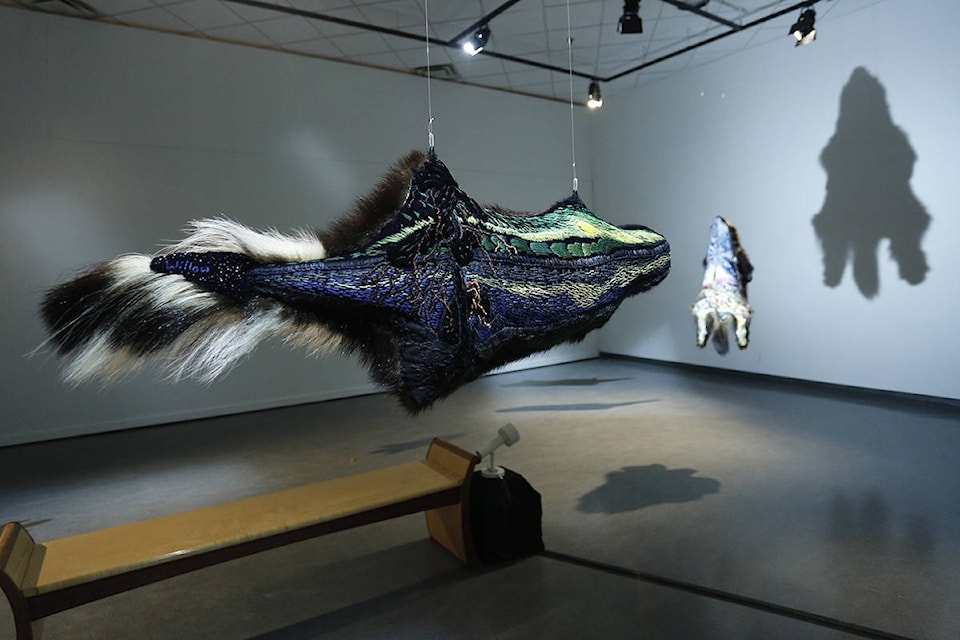Stepping into Winnipeg-based artist Willow Rector’s new show Trapped is immediately arresting — in part because the delicate, detailed embroidery work is so bright and striking, but also because arresting one’s movements is the correct response to seeing a skunk.
Hanging suspended by a pair of wires, the piece —also called, Trapped — floats with its back to the observer, white stripe flashing a warning which is primarily embedded in the brain of anyone who has lived far enough south to have encountered skunks before. Once you’re over this, however, and realize the skin is just a skin (which, having been cleaned, is odourless) you can fully appreciate the rich nuance of the work.
“The skunk was the first piece in this collection … it’s a metaphor as well as a reference to the literal trapline,” Rector said. “In so many ways, we’ve trapped ourselves in our culture.”
The idea to work with animal skins this way — taking the skin of a once-alive, wild animal that had been trapped and made into a pelt and then creating an embroidered image on the skin side — started out “very playfully” when Rector was taking part in a small show in Winnipeg with the theme of “midnight petting zoo,” she said.
“I was literally vacuuming one day and I had this phrase come into my head and it was ‘glitter skunk’… and I was like, ‘what is that all about?’”
Rector became enamoured with the idea. She reached out to a furrier, from whom she acquired the skunk pelt. Rector also pointed out that this particular skunk — which would probably have been about the same size as a healthy Yukon porcupine when it was alive — was exceptionally large, and would have been “a real bruiser.”
“It was very visceral,” Rector, who had never worked with pelts before, said. “She smelled like a skunk, she had all these wounds on her…. I wanted to repair some of the wounds.” (Rector refers to all of her pieces as “she” regardless of what sex the animal was, because she considers her work to be a feminine process).
“It got serious very fast after that…. I realized very quickly that what I was working with had once been a living creature.”
Rector reached out and touched the work, pointing out places where the hide had been torn. Skunks have no commercial value, and the animals are often caught as “nuisances,” so they are often treated roughly, she said. Rector took these damaged places and stitched them up, closing the injuries with beads as part of the creation process.
The skunk pelt is remarkably soft — sleek, less like cat fur and more like a ferret, but longer — although Rector asks that viewers resist the urge and keep their hands off the delicate hides.
Each of the pieces on display in Trapped is its own, separate, singular, once-living animal with its own theme and design which Rector crafted specifically for each pelt, with the goal of “placing (them) in an environment that was nurturing and familiar … trying to rebuild the animal…. What features of their lives would they remember the most?”
Much of the embroidery Rector has created are based on the landscape paintings of the Group of Seven. The eponymous Trapped, for example, features a copy of a work by Tom Thomson. Initially, Rector said she wanted to focus on the Group of Seven aspect of the work, but says that is changing for her.
“There’s a stereotypical view created by the Group of Seven and it’s no longer appreciated. All the changes that have been made to this land have affected these animals,” she said. “Many of the places the Group of Seven painted wouldn’t even be recognizable to them anymore.”
“It’s the animal pelts and the stories of the animals themselves that are really driving this project now.”
The exhibit, which contains a variety of northern animals, also features a one-time Yukon resident: a wolverine pelt, trapped in the Yukon.
The wolverine alone took 27 months to complete, which is the nature of this kind of work, Rector said. Embroidery is naturally a slow, “meditative” process, she added.
“I think one of the reasons (embroidery) isn’t practiced much today is speed. It demands that you focus.”
The wolverine in particular is of special importance to her, she said, partly because of how vulnerable the animal is to human intrusion. Wolverines are projected to be extinct in the continental United States in 30 years, she said, because the animals have such large habitat ranges and small litters.
“They require so much land, their biggest enemy is urban sprawl and deforestation…. They have a hard time adapting to change. In some ways they are the exact opposite of the coyote,” she said. “So it’s doubly important for me to honour this creature.”
“It’s a reclamation project, a celebration project. It’s about transforming things that could kill you into something that breathes.”
Trapped runs through until Nov. 25 at the Yukon Arts Centre public gallery.
Contact Lori Garrison at lori.garrison@yukon-news.com
